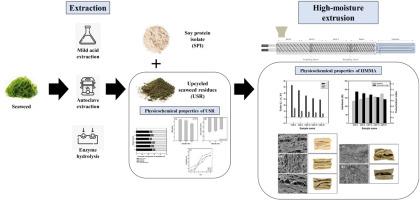Upcycling seaweed residues via comparative pretreatment evaluation to develop functional protein ingredients for soy-based high-moisture meat analogs
IF 11
1区 农林科学
Q1 CHEMISTRY, APPLIED
引用次数: 0
Abstract
Growing environmental concerns and demand for sustainable diets are driving interest in alternative proteins for plant-based meat analogs. Seaweeds are an attractive option due to their high protein and nutrient content, but their tough cell walls make protein extraction challenging. Upcycled seaweed residues (USR) offer a sustainable solution for developing functional protein ingredients. Therefore, this study systematically evaluates seaweed residues subjected to different pretreatments, mildly acidic extraction, autoclaving, and enzymatic hydrolysis, to develop functional protein ingredients for soy-based high-moisture meat analogs. Among these, enzymatic hydrolysis significantly enhances the protein purity and solubility while reducing the water holding capacity and surface charge stability. When incorporated into Soy Protein Isolate (SPI) blends, USR alters the gelation behavior and enhances the gel strength and hardness owing to thermally induced polysaccharide–protein interactions. However, higher USR concentrations (≥15 %) compromise structural anisotropy, as indicated by lower texturization indices, disrupted fibrous structures, and an increased proportion of random coil structures. Chemical analysis further reveals weakened hydrogen bonds, disulfide bonds, and hydrophobic interactions at elevated USR levels, highlighting the adverse effects of excessive USR incorporation on protein network formation. Consequently, moderate inclusion (≤10 %) of USR proves optimal, achieving a balance between improved mechanical properties and desirable fibrous texture. These findings highlight the potential of enzymatically treated USR as a sustainable and functional protein-rich ingredient in advanced plant-based meat analog formulations.

通过比较预处理评价对海藻残留物进行升级利用,开发大豆基高水分肉类类似物的功能性蛋白质成分
日益增长的环境问题和对可持续饮食的需求正在推动人们对植物性肉类类似物的替代蛋白质的兴趣。海藻是一个有吸引力的选择,因为它们的蛋白质和营养含量高,但它们坚韧的细胞壁使蛋白质的提取具有挑战性。升级利用海藻残渣为开发功能性蛋白质成分提供了可持续的解决方案。因此,本研究系统地评价了经过不同预处理、微酸提取、高压灭菌和酶解的海藻残留物,以开发大豆基高水分肉类类似物的功能性蛋白质成分。其中,酶水解显著提高了蛋白质纯度和溶解度,但降低了持水能力和表面电荷稳定性。当掺入大豆分离蛋白(SPI)混合物时,由于热诱导的多糖-蛋白质相互作用,USR改变了凝胶行为,提高了凝胶强度和硬度。然而,较高的USR浓度(≥15%)损害了结构的各向异性,如织构化指数降低、纤维结构破坏和随机线圈结构比例增加。化学分析进一步揭示了USR水平升高时氢键、二硫键和疏水相互作用减弱,突出了过量USR掺入对蛋白质网络形成的不利影响。因此,适量的USR(≤10%)被证明是最佳的,可以在改善的机械性能和理想的纤维结构之间取得平衡。这些发现突出了酶处理USR作为先进植物性肉类类似物配方中可持续和功能性富含蛋白质的成分的潜力。
本文章由计算机程序翻译,如有差异,请以英文原文为准。
求助全文
约1分钟内获得全文
求助全文
来源期刊

Food Hydrocolloids
工程技术-食品科技
CiteScore
19.90
自引率
14.00%
发文量
871
审稿时长
37 days
期刊介绍:
Food Hydrocolloids publishes original and innovative research focused on the characterization, functional properties, and applications of hydrocolloid materials used in food products. These hydrocolloids, defined as polysaccharides and proteins of commercial importance, are added to control aspects such as texture, stability, rheology, and sensory properties. The research's primary emphasis should be on the hydrocolloids themselves, with thorough descriptions of their source, nature, and physicochemical characteristics. Manuscripts are expected to clearly outline specific aims and objectives, include a fundamental discussion of research findings at the molecular level, and address the significance of the results. Studies on hydrocolloids in complex formulations should concentrate on their overall properties and mechanisms of action, while simple formulation development studies may not be considered for publication.
The main areas of interest are:
-Chemical and physicochemical characterisation
Thermal properties including glass transitions and conformational changes-
Rheological properties including viscosity, viscoelastic properties and gelation behaviour-
The influence on organoleptic properties-
Interfacial properties including stabilisation of dispersions, emulsions and foams-
Film forming properties with application to edible films and active packaging-
Encapsulation and controlled release of active compounds-
The influence on health including their role as dietary fibre-
Manipulation of hydrocolloid structure and functionality through chemical, biochemical and physical processes-
New hydrocolloids and hydrocolloid sources of commercial potential.
The Journal also publishes Review articles that provide an overview of the latest developments in topics of specific interest to researchers in this field of activity.
 求助内容:
求助内容: 应助结果提醒方式:
应助结果提醒方式:


